USB 3.2 Gen 2x2 State of the Ecosystem Review: Where Does 20Gbps USB Stand in 2020?
by Ganesh T S on October 5, 2020 10:30 AM EST- Posted in
- Storage
- SSDs
- Western Digital
- SanDisk
- ASMedia
- USB 3.2 Gen 2x2
PCMark 10 Storage Bench - Real-World Access Traces
There are a number of storage benchmarks that can subject a device to artificial access traces by varying the mix of reads and writes, the access block sizes, and the queue depth / number of outstanding data requests. We saw results from two popular ones - ATTO, and CrystalDiskMark - in a previous section. More serious benchmarks, however, actually replicate access traces from real-world workloads to determine the suitability of a particular device for a particular workload. Real-world access traces may be used for simulating the behavior of computing activities that are limited by storage performance. Examples include booting an operating system or loading a particular game from the disk.
PCMark 10's storage bench (introduced in v2.1.2153) includes four storage benchmarks that use relevant real-world traces from popular applications and common tasks to fully test the performance of the latest modern drives:
- The Full System Drive Benchmark uses a wide-ranging set of real-world traces from popular applications and common tasks to fully test the performance of the fastest modern drives. It involves a total of 204 GB of write traffic.
- The Quick System Drive Benchmark is a shorter test with a smaller set of less demanding real-world traces. It subjects the device to 23 GB of writes.
- The Data Drive Benchmark is designed to test drives that are used for storing files rather than applications. These typically include NAS drives, USB sticks, memory cards, and other external storage devices. The device is subjected to 15 GB of writes.
- The Drive Performance Consistency Test is a long-running and extremely demanding test with a heavy, continuous load for expert users. In-depth reporting shows how the performance of the drive varies under different conditions. This writes more than 23 TB of data to the drive.
Despite the data drive benchmark appearing most suitable for testing direct-attached storage, we opted to run the full system drive benchmark as part of our evaluation flow. Many of us use portable flash drives as boot drives and storage for Steam games. These types of use-cases are addressed only in the full system drive benchmark.
The Full System Drive Benchmark comprises of 23 different traces. For the purpose of presenting results, we classify them under five different categories:
- Boot: Replay of storage access trace recorded while booting Windows 10
- Creative: Replay of storage access traces recorded during the start up and usage of Adobe applications such as Acrobat, After Effects, Illustrator, Premiere Pro, Lightroom, and Photoshop.
- Office: Replay of storage access traces recorded during the usage of Microsoft Office applications such as Excel and Powerpoint.
- Gaming: Replay of storage access traces recorded during the start up of games such as Battlefield V, Call of Duty Black Ops 4, and Overwatch.
- File Transfers: Replay of storage access traces (Write-Only, Read-Write, and Read-Only) recorded during the transfer of data such as ISOs and photographs.
PCMark 10 also generates an overall score, bandwidth, and average latency number for quick comparison of different drives. The sub-sections in the rest of the page reference the access traces specified in the PCMark 10 Technical Guide.
Booting Windows 10
The read-write bandwidth recorded for each drive in the boo access trace is presented below.
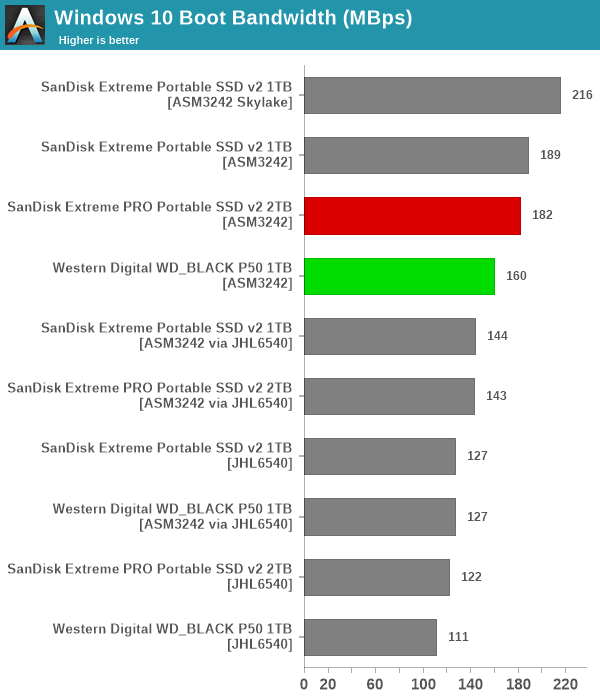
USB SuperSpeed 20Gbps doesn't matter for the boot process - in fact, the Extreme Portable SSD v2 using the SN550E behind a USB 3.2 Gen 2 (10 Gbps) bridge scores better than the P50 and the Extreme PRO v2 on the Haswell testbed in this benchmark.
Creative Workloads
The read-write bandwidth recorded for each drive in the sacr, saft, sill, spre, slig, sps, aft, exc, ill, ind, psh, and psl access traces are presented below.
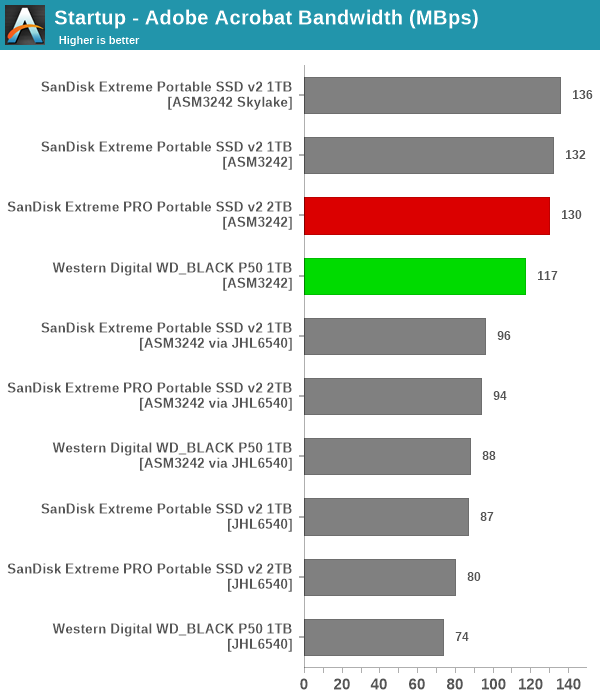
These workloads also seem to get little benefit from the move to USB SuperSpeed 20Gbps. In almost all cases, the SanDisk Extreme v2 performs better than the Extreme PRO v2 on the same testbed. The P50 seems to suffer from some handicaps for these types of workloads.
Office Workloads
The read-write bandwidth recorded for each drive in the exc and pow access traces are presented below.
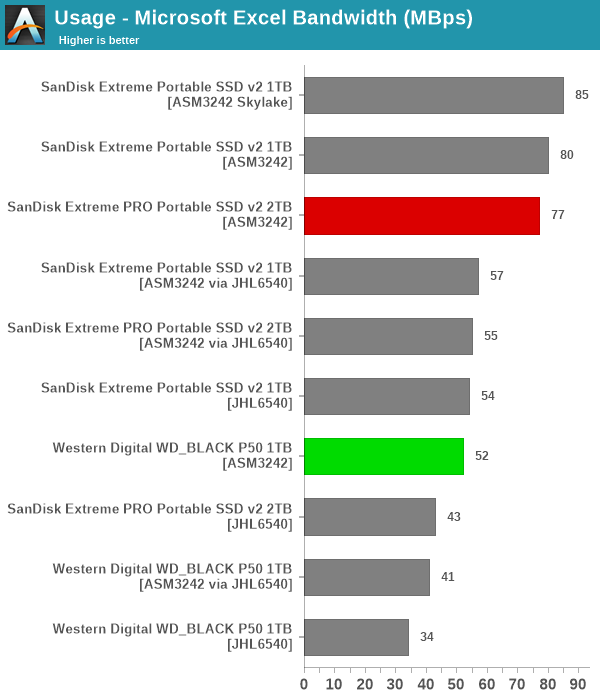
The trend seen in earlier PCMark 10 storage workloads repeats here - the Extreme edging out the Extreme PRO v2 slightly, while the P50 lags well behind.
Gaming Workloads
The read-write bandwidth recorded for each drive in the bf, cod, and ow access traces are presented below.
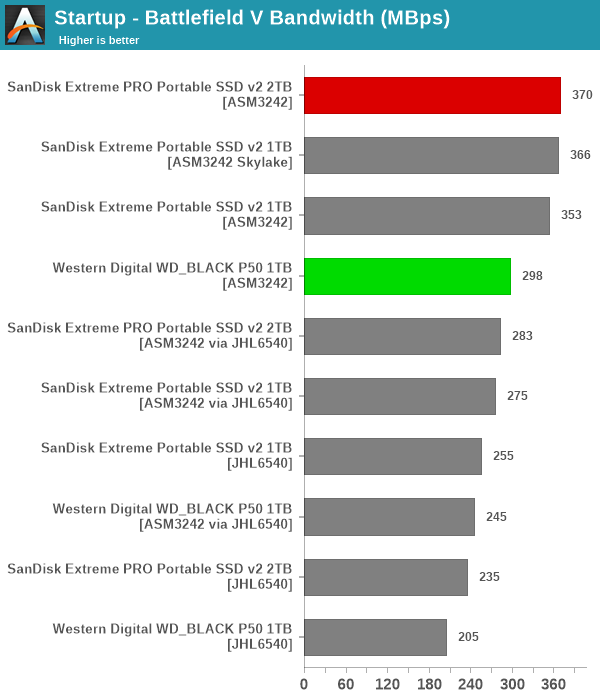
This section finally sees the P50 live up to its billing as a game drive - in the Call of Duty loading times, it finally scores almost as well as the Extreme PRO v2, and the Extreme v2 lags well behind. However, overall, the Extreme PRO v2 seems to be a better fit for gaming workloads.
Files Transfer Workloads
The read-write bandwidth recorded for each drive in the cp1, cp2, cp3, cps1, cps2, and cps3 access traces are presented below.
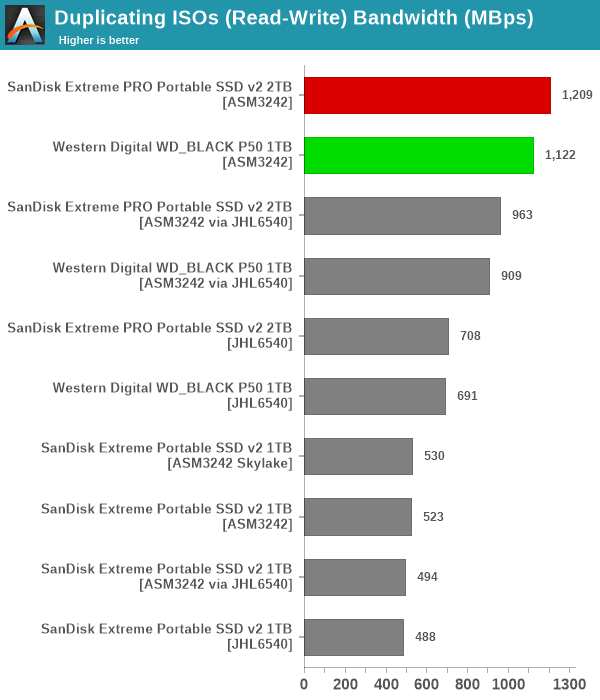
In most workloads, the USB SuperSpeed 20Gbps drives come out on top, with the Extreme PRO v2 slightly edging out the P50.
Overall Scores
PCMark 10 reports an overall score based on the observed bandwidth and access times for the full workload set. The score, bandwidth, and average access latency for each of the drives are presented below.
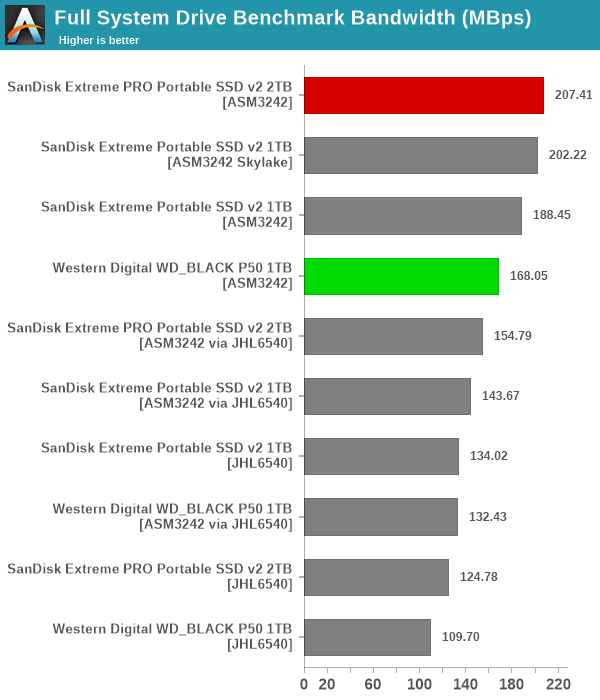
The WD_BLACK P50 scores are a bit behind the Extreme PRO v2 and the Extreme v2 when considered on a testbed-by-testbed basis. When limited by the host port to 10Gbps, the gulf is not significant, though. It may just be that Western Digital has tweaked the firmware of the P50 to cater to gaming workloads alone.










81 Comments
View All Comments
DanNeely - Monday, October 5, 2020 - link
Read the last page of the article. The USB maintainers have decided to make USB4 even more of a garbage fire of confusion than previous versions. USB4-20gb and USB-40gb ports are only required to support 10gb data rates for USB drives (and can count bandwidth to alternate data stream devices, ie parallel video out) toward the total.IMO it's past time to disband the current USB group, and create a new C(ompetant)SB organization to maintain future standards that bans anyone involved in the USB 3.x/4.x nomenclature from membership.
Spunjji - Monday, October 5, 2020 - link
I'm actually inclined to agree. It's gone way, way past being a joke at this stage.Kangal - Tuesday, October 6, 2020 - link
Well, we can always ditch USB3.1 / USB4 as consumers.Instead ask for USB-A (3.0) for legacy support, and then opt for USB-C (TB4) instead. Just say "hell no" to the USB-IF consortium and their broken standards.
Yet, that might be okay for now/per individual, but it's not gonna solve anything in the long run. And even worse, we can't actually do that because there is a lack of options in the market (ie You don't get to choose which ports your device has, you are stuck with whatever option they deem good for you). Tough times.
repoman27 - Monday, October 5, 2020 - link
Stop spreading FUD and read the specs, they're freely available for download. USB4 operates at 20Gbps (Gen 2x2) or 40Gbps (Gen 3x3) but it's a tunneling protocol, i.e. a *totally different* protocol than USB3. Backwards compatibility is mandatory and at least USB3 10Gbps (Gen 2x1) as well USB 2.0 signaling is required. USB 2.0, 3.2 and 4 involve different signaling and different protocols.USB4 supports tunneling of PCIe and DisplayPort packets in addition to native USB packets so that the total bandwidth can be flexibly and efficiently shared. Not bothering to understand this and instead spewing internet outrage helps no one.
repoman27 - Monday, October 5, 2020 - link
D'oh, that should have been "40Gbps (Gen 3x2)".ganeshts - Monday, October 5, 2020 - link
@repoman27's technical explanation is A-OK :) The move to tunnelling is definitely a big step for USB.However, @DanNeely's comment is also correct from a *consumer* viewpoint ; Would a regular non-tech savvy consumer care about tunnelling? If he sees USB4 20Gbps, would it be unfair for the person to expect his USB SuperSpeed 20Gbps device to work to its full potential in it?
All these problems could have been avoided if USB 3.2 Gen 2x2 capabilities were integrated into USB4 as mandatory.
repoman27 - Monday, October 5, 2020 - link
Oh, totally. But on the other hand, if Intel had just included USB 3.2 dual-lane operation in Tiger Lake / Thunderbolt 4, nobody would have realized it was optional, because it would have been supported everywhere one might expect it. I’m afraid that Intel intends to completely forego USB 3.2 dual-lane operation in favor of Thunderbolt.Kevin G - Monday, October 5, 2020 - link
It mainly boils down to USB 3.2 @ 20 Gbit not being the same implementation as USB 4 @ 20 GBit, a very year 2020 problem to have.There is still interoperability between the two but that knocks the speeds down to 10 Gbit. That is noticeable for things like storage doing transfers on fast SSDs etc. From a consumer stand point though, things will still work which I would rank as more important.
I will say that these issues lay with the USB consortium as they've created a mess of specifications that makes it difficult for things to work *as advertised*. Historically they also have needed to crackdown to lazy implementations and bad cables. Give that group a bit of teeth to enforce their spec and things would be far better for consumers today.
repoman27 - Monday, October 5, 2020 - link
Well, at the risk of beating a dead horse, nothing prevents a USB4 host/device from also supporting USB 3.2 20Gbps. It’s just that it’s optional, Intel didn’t include it in Tiger Lake, and I’m not aware of anything on their roadmap that will in the near future.You can choose to blame the USB-IF, Intel, or the fact that Intel pretty much runs the USB-IF. But at this point Intel hasn’t shown us any products containing USB 3.2 20Gbps IP, and without Intel on board, I’m not sure what kind of future that standard has.
Spunjji - Wednesday, October 14, 2020 - link
Makes sense. They've been artificially holding the standard back ever since they decided they'd rather push Thunderbolt over USB 3.